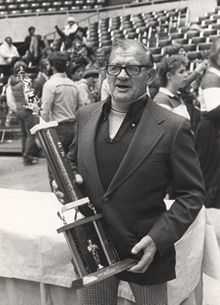Harold Nichols
| Harold Nichols | |
|---|---|
 Harold Nichols | |
| Born |
March 22, 1917 Cresco, Iowa |
| Died |
February 22, 1997 Ames, Iowa |
| Nationality | United States |
| Occupation | wrestling coach |
| Known for |
NCAA individual wrestling champion, 1939 Coached Iowa State to six NCAA team wrestling championships |
Harold Nichols (March 22, 1917 - February 22, 1997) was a collegiate wrestler and wrestling coach. He won the 1939 NCAA individual championship and went on to coach college wrestling for 37 years. He built the Iowa State Cyclones into a national wrestling power. In 32 years at Iowa State, Nichols' wrestlers won six NCAA team championships and 38 NCAA individual championships.
College wrestler
A native of Cresco, Iowa, Nichols attended the University of Michigan to wrestle under legendary wrestling coach, Cliff Keen. While at Michigan, Nichols won the NCAA collegiate wrestling championship of 1939 in the 145-pound weight class.[1] He interrupted his college studies to serve in the U.S. Army Air Corps in World War II. After the war, he received a master's degree at the University of Illinois and a doctorate at Michigan.[2]
Wrestling coach
He later became a wrestling coach, described by The New York Times as "one of college wrestling's most successful and respected coaches."[3] Nichols began his coaching career in 1948 at Arkansas State University, compiling a 37-18-3 record in five years.[2] In 1954, he became the coach at Iowa State University, where he remained as coach for 32 years.[3] In 37 years as a college wrestling coach, Nichols compiled a record of 492-93-14.[3] He became Iowa State's coach in 1954, and his first Cyclone team went 8-0. He remained the coach at Iowa State until 1985, and built Iowa State into a national wrestling powerhouse. In 32 years at Iowa State, his Cyclone teams were 456-75-11 and placed among the top three teams in the country 26 times, winning six NCAA team championships, and finishing second 11 times and third 9 times.[4] From 1957-1983, the Cyclones only once finished lower than fourth place in the national meet.[4] Nichols' peak years at Iowa state were the nine years from 1965–1974, during which time his teams won five national titles, three runner-up awards and a third-place finish.[4]
Nichols' wrestlers also won 38 individual NCAA championships, 91 individual Big Eight Conference championships and seven Olympic medals.[2] At the 1972 Summer Olympics, two of his wrestlers, Dan Gable and Ben Peterson won gold medals. A third, Chris Taylor, won a bronze medal.[4] Nichols' pupil Dan Gable went on to coach wrestling at the University of Iowa for 21 years.[3] Nichols retired in 1985.[3]
Nichols was considered to be "ahead of his time concerning race relations," and was a pioneer in bringing minorities into college wrestling, including African Americans, Hispanics and Cubans.[4]
Nichols was known as "Nick" to the wrestling world.[4]
Pottery collector
In addition to wrestling, Nichols had a passion for collecting pottery. In 1983, he appeared on Late Night with David Letterman with a seven-foot-tall vase from his collection, considered one of the world's largest.[4]
Honors
Nichols was inducted into the University of Michigan Athletic Hall of Honor in 1983. He was named national coach of the year three times and Wrestling Man of the Year by Amateur Wrestling News. He has also been inducted into the National Wrestling Hall of Fame, the Iowa Wrestling Hall of Fame and the Helms Foundation Wrestling Hall of Fame.[4]
Family and death
Nichols died in February 1997 at age 79 in Ames, Iowa.[4] He was survived by his wife, Ruth, and sons William and Harold.[2]
See also
References
- ↑ "Wrestling: NCAA Champions". University of Michigan, Bentley Historical Library.
- ↑ 2.0 2.1 2.2 2.3 "ISU Wrestling Legend Dies". Telegraph Herald (Dubuque, IA). 1997-02-24.
- ↑ 3.0 3.1 3.2 3.3 3.4 "Harold Nichols Wrestling Coach, 79". The New York Times. 1997-02-24.
- ↑ 4.0 4.1 4.2 4.3 4.4 4.5 4.6 4.7 4.8 Steve Jones (May 1997). "Wrestling legend Nichols dies". The Iowa Stater.
| |||||